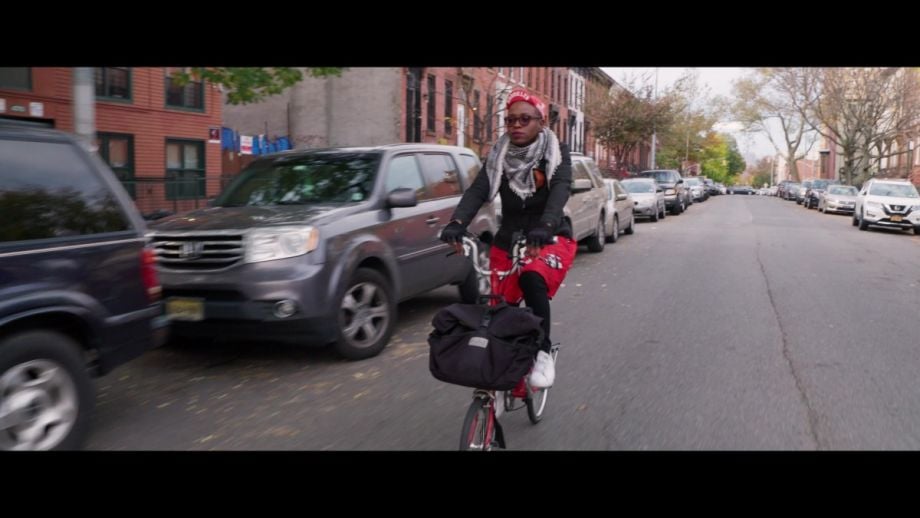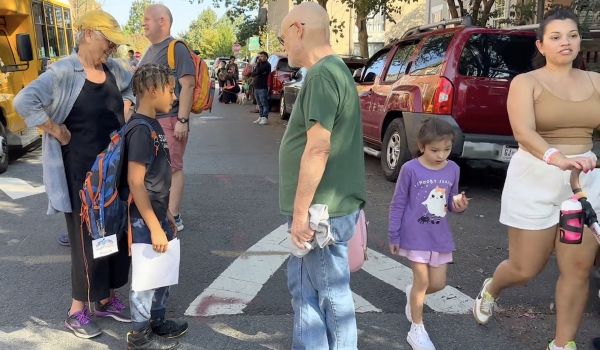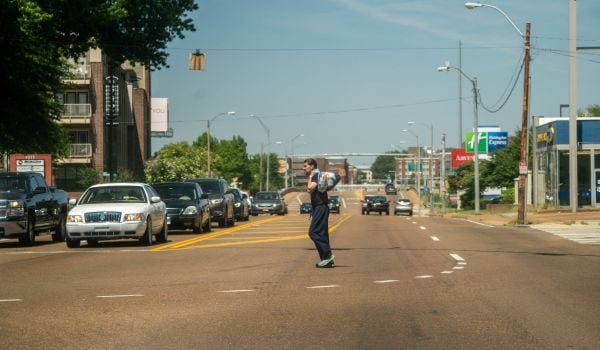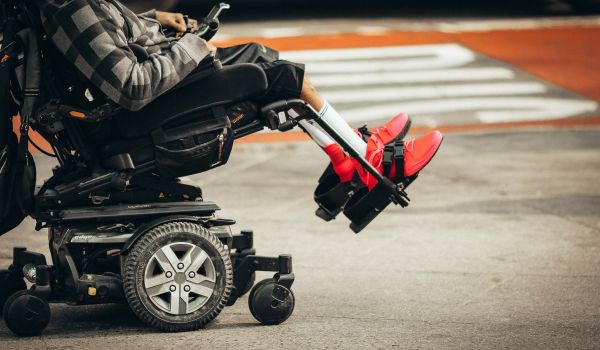There’s a chilling scene in “The Street Project,” a new PBS documentary about why streets in America are so deadly — but there’s no blood, guts or gore. Instead, the filmmakers line up children one-by-one in a single file line, right in front of a parked SUV, sitting them down on the ground until the driver signals that she can see a child. How many kids does it take? Ten.
I held my breath, even though I knew the children weren’t actually in danger. This visual illustrates just how dangerous our streets can be and how the size and shape of vehicles plays a role. But SUVs, as the filmmakers point out, are not the only culprit.
Who do the streets belong to? Do they belong to cars? Or do they belong to everyone? “The Street Project” comes down firmly on the side of “everyone.” But America’s car culture can prove tough to crack.
Jennifer Boyd, producer, writer, director and founder of Boyd Productions, initially set out to tell the story of distracted pedestrians after spotlighting distracted drivers in her documentary and podcast series “3 Seconds Behind the Wheel.” But she found that people weren’t dying because they were walking down the street glued to their phones. They were dying for lots of other reasons.
Boyd spent four years documenting just how unsafe streets are for vulnerable road users and how cars dominate what she calls “our largest public space,” all to answer one question: Why are the streets so unsafe for people outside of cars? The documentary explores everything from zoning to victim-blaming to structural racism to a car-centric culture that values driving at high speeds over human life.
Traffic deaths have soared in recent years with 42,915 people killed in 2021 alone, according to the National Highway Traffic Safety Administration. Pedestrians and cyclists are especially vulnerable, with a 13% and 5% increase in fatalities compared to 2020.
And it doesn’t have to be this way. The documentary goes abroad seeking inspiration for how European cities have made their streets safer, looking closely at Copenhagen’s work since the 1980s to redesign its streets to put pedestrian and cyclist safety at the forefront.
By focusing on community advocates and the global movement to “take back our streets,” Boyd says she sought to make a documentary about traffic violence that is “positive and inspiring.”
Dulcie Canton, one of the activists featured in the documentary, has a personal history with traffic violence. In 2014 – a decade after her mother was also the victim of a hit-and-run as a pedestrian – Canton was hit by a driver while biking, sustaining major injuries. The driver didn’t even slow down.
“He’s still driving today,” she notes. “Maybe he pays more insurance. Maybe — we hope.”
After the crash, Canton became a community organizer in New York City, advocating for new bike lanes, better cycling infrastructure and more inclusive streets. Canton, who is a former Brooklyn organizer for Transportation Alternatives and works for the ebike company VanMoof, noticed that most victims of hit-and-run crashes were lower-income people and BIPOC. Indeed, a new report from Smart Growth America, finds that Black pedestrians faced twice the fatality rates of white pedestrians and pedestrians from low-income communities saw disproportionately high fatalities.
“The Street Project” highlights the persistence of pedestrian and cyclist shaming, turning to Peter Norton, author of “Fighting Traffic,” prominent urban planner Jeff Speck, author of “Walkable City,” and urban designer Mikael Colville-Andersen for their expertise. The history of pedestrian shaming goes all the way back to the 1920s when the car industry invented jaywalking, making vulnerable road users responsible for their own safety and even culpable for their own deaths. It’s a culture that continues today.
“When they come at cyclists and we get hit, and they say, ‘Was the cyclist wearing a helmet? Did they have on reflective gear?’” says Canton. Even in the reception to the film, Canton and Boyd told Next City that there’s been pushback on the topic of helmets: “How can you create a bike safety documentary and your central character isn’t wearing a helmet?,” some have asked, as Boyd notes.
But as she points out, the U.S. has higher rates of helmet use and higher fatality rates when compared to other countries. Whatever the case, the documentary is trying to shift the viewer from an individualistic “Your safety, your problem” mindset to viewing cyclist and pedestrian safety as a collective responsibility.
Stacey Champion, a community advocate in Phoenix, who was also featured in the film, has been fighting for safer streets for almost 15 years. At her neighborhood crosswalk, cars hit five pedestrians over the course of six months.
“It shouldn’t take people physically dying to make positive change, yet that is more often than not the case,” she says.
Champion says that the streets in Phoenix are “dangerous by design” with “big, wide fast-moving stroads” (a term coined by Strong Towns to describe multi-laned thoroughfares that combine a street and road) and not enough crosswalks.
“As a result of people not wanting to walk an extra mile when it’s 110-plus degrees, we have a lot of pedestrian fatalities,” she notes. And progress is slow for improvements that would make streets safer. In one memorable scene, a city councilman opposes adopting Vision Zero because he claims it would make traffic worse (the city did eventually adopt the plan).
“You have to be patient, you have to be tenacious, you kind of have to be like a pitbull,” Champion advises. “Put your teeth in it and you do not let go.”
“It’s a low and slow process, everything you’re going to get involved with,” Canton adds. “Don’t get frustrated. It’s going to take time and changing people’s minds and hearts.”
But sometimes change happens all at once due to an unforeseen global pandemic.
According to Boyd, the emotional core of the film was a surprise, even to her. After Covid scuttled 30 days of filming in Europe, the filmmakers were finally able to resume filming with the 34th Avenue Open Street Coalition, a project in Queens, New York City, to shut down 26 blocks of the street each day for residents to walk, bike, skate, play and socialize with their neighbors.
The Jackson Heights neighborhood was at the epicenter of COVID-19 in the pandemic’s very early days. “They needed an open street because they were desperate,” says Boyd. “Humans need to be with each other, they need to connect.”
Perhaps it’s telling that the most emotionally resonant moment of the entire documentary has nothing to do with traffic violence and everything to do with human connection — Jim Burke, co-founder of the Queens coalition, tears up while talking about how he can’t walk one block anymore down the street without running into someone that he knows. That open streets project is still going strong today.
Reclaiming the streets from cars means more than just preventing traffic violence, Boyd says. It means reimagining what our streets could be if we made space for everyone.
“We have to reshape and reframe how we think about these issues. And then it becomes an ‘Aha!’ moment for people. And then hopefully they take action because it doesn’t have to be hard and it can be pretty joyful.”
The Street Project premieres Aug. 25 on PBS International and Amazon TV.

Maylin Tu is Next City's Equitable Cities Reporting Fellow for Social Impact Design. A freelance reporter based in Los Angeles, she writes about transportation and public infrastructure (especially bus shelters and bathrooms), with bylines in the Guardian, KCET, Next City, LAist, LA Public Press and JoySauce. She graduated with a BA in English from William Jewell College in Missouri.
Follow Maylin .(JavaScript must be enabled to view this email address)




_600_350_80_s_c1.jpg)


_on_a_Sunday_600_350_80_s_c1.jpeg)








